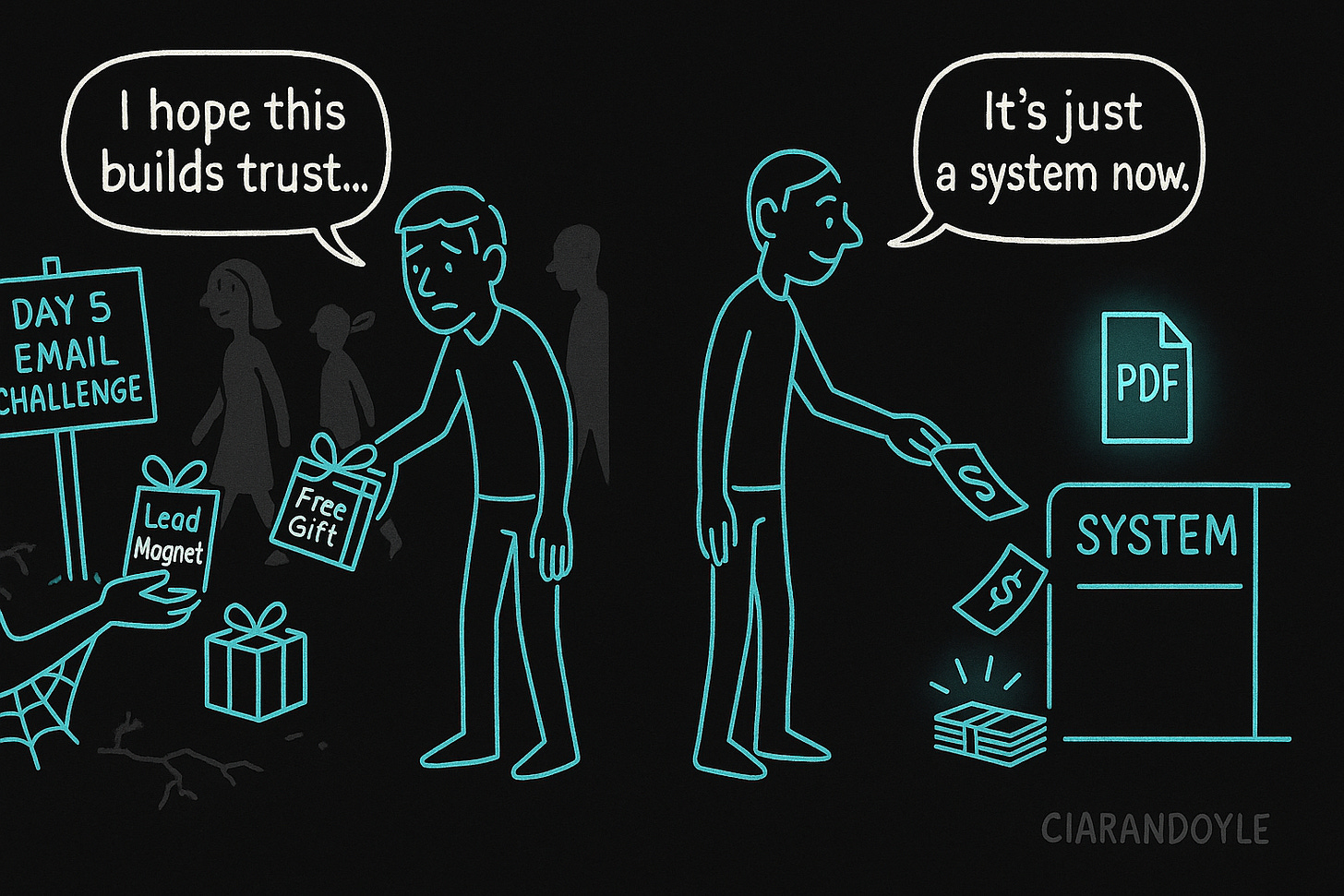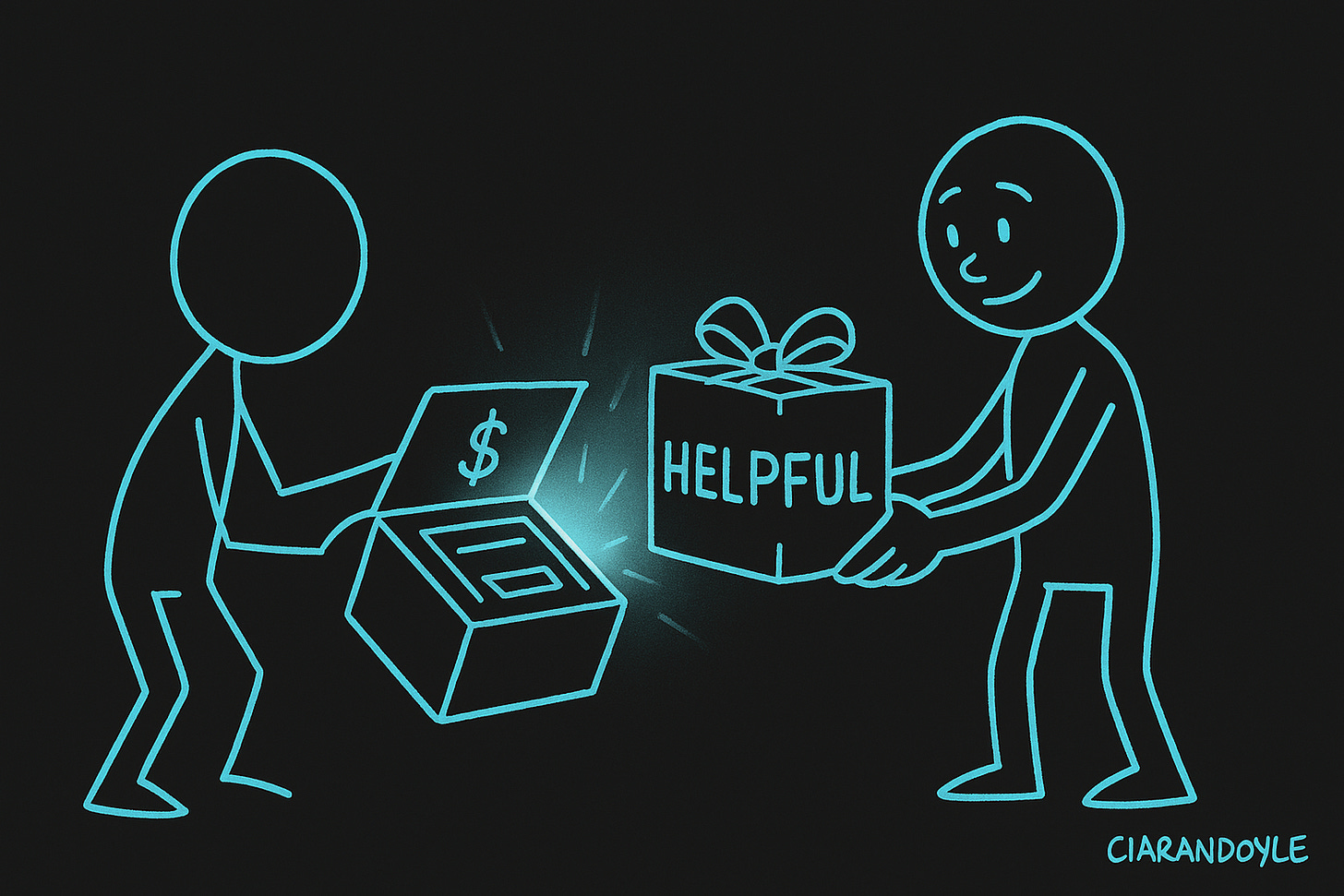Affiliate notification: $100.
Then another. Then another.
By the end of the day, a single free PDF I’d dropped in a couple of online groups had stacked up $900.
There was no funnel.
No webinar.
No 5-day email challenge.
Just a simple, useful PDF.
Most creators are told to “give value” first.
They spend weeks crafting the perfect lead magnet, a beautiful freebie they offer in exchange for an email.
Then they wait.
They hope that gift builds enough trust to maybe, someday, lead to a sale.
They’re giving away free stuff and hoping it leads somewhere.
I treat every freebie like a money printer.
And it’s not a hack… it’s a system.
A system built on a belief that has saved me from burnout more times than I can count: complexity is a tax on momentum.
The Great “Value” Lie That Keeps Creators Broke
The online business world is obsessed with the “value ladder.”
It’s a neat little diagram that shows a customer ascending from a freebie to a low-ticket offer, then a course, then high-ticket coaching.
It looks clean on a whiteboard.
It sounds smart in a marketing seminar.
But for the solo creator, it’s often a roadmap to absolute tiredness.
You’re told to give, give, give, and then ask.
What was Gary’s book… “Jab, jab, jab… right hook”?
But what if your giving could *also* be your asking?
What if the value itself was the sales pitch?
The problem isn’t giving value.
The problem is creating dead ends.
A freebie that only collects an email address is a dead end.
It places the entire burden of conversion on your next step, the email sequence, the sales page, and the launch event.
That’s an immense amount of pressure.
Fu*k That.
What if you could get paid from day one, simply by being helpful?
The Story of the $19 Checklist
I once worked with a client, Sarah. She had spent the better part of a year building a comprehensive course on productivity for authors.
It was brilliant.
It was also a digital ghost, haunting her hard drive because she was terrified to launch it.
The fear of it not being perfect, of no one buying, had paralyzed her. She was drowning in her own unfinished idea.
Instead of coaching her on a launch strategy, I told her to do the opposite.
“Forget the course,” I said. “Go into Chapter 4, pull out that ‘5-Day Writing Sprint Checklist,’ and save it as a 3-page PDF.”
She was confused. “And then what? Give it away?”
“Yes,” I said. “But we’re going to bake the money *into* the help.”
Inside the checklist, she mentioned the software she used to block out distractions.
We added her affiliate link.
At the end of the PDF, we added a small, unobtrusive line:
“P.S. If you loved this sprint, the full system with 12 more frameworks is inside my Author’s OS course.”
We linked to a simple checkout page for just $19.
She didn’t have to “sell” anything.
She just had to be useful.
She posted the free PDF in two Facebook groups for writers.
That evening, she sent me a screenshot of her first-ever Stripe notification.
Nineteen dollars.
And also, an affiliate commission from her distraction tool.
It wasn't life-changing money.
But it changed her life.
It broke the spell.
It was the first few dollars she had ever made from her knowledge, and it came not from a scary, high-stakes launch but from a simple, helpful document.
She didn’t need a fifty-step funnel… she needed a simple execution engine that fit her life.
The Monetized Freebie System: From Free to Foot-in-the-Door
This isn’t about tricking people.
It’s about creating a seamless path from problem to paid solution.
If you solve a small part of my problem for free, I’m exponentially more likely to trust you to solve the whole thing.
Here’s the system. It’s not complex, because strategy, not tools, is what works.
Step 1: Create a Damn Useful Asset (Not a Fluffy "Gift")
This is the most important step.
Your freebie can’t be a vague ebook.
It must solve a specific, nagging pain.
Think checklists, cheat sheets, mini-guides, or a stack of AI prompts that deliver a quick win.
The goal is a high outcome from low effort.
Focus on getting someone a tangible result in minutes, not days.
This isn't about teasing; it's about proving that finishing is possible.
Step 2: Bake in the Revenue Hooks
Your free asset is not a gift… It’s a product with a price of zero.
And like any good product, it has pathways to more value.
Embed these directly and transparently…
Affiliate Links: Recommend tools you genuinely use and believe in. If you’re sharing a social media template, link to the scheduling tool that saves you hours.
The Soft Product Plug: Just like Sarah did, include a small P.S. that points to your main course, community, or service.
Frame it as the logical next step for those who want to go deeper.
The Tripwire Page: This is slightly more advanced. When someone downloads your freebie, the “thank you” page shouldn’t be a dead end.
Instead, it offers a one-time deal on a valuable, low-cost product ($7-$49).
It’s an impulse buy that turns a free user into a paying customer immediately.
Here's what one of my real tripwire pages looks like.
Step 3: Plant It Where the Pain Lives
Forget complex ad campaigns.
Go where your people are already talking about their problems.
Reddit threads, Facebook groups, Twitter/X replies, Quora questions.
Don’t spam your link.
Answer a question thoughtfully, provide real value in the comment itself, and then offer the PDF as a way to get the full, organized solution.
I once saw a question on Reddit about organizing client work.
I wrote a three-paragraph reply outlining my method and ended with: “I actually turned this into a one-page checklist for my own use. Happy to share if it’s helpful.”
No hard sell. Just an offer.
That single comment drove stacks of downloads and a few hundred dollars in affiliate sales.
Quick Recap: The Monetized Freebie System
Create a useful, specific mini-product that solves a real pain.
Bake in revenue hooks: affiliate links, soft upsells, or a tripwire.
Post it where your audience is stuck and asking for help.
Done right, every download becomes a trust-builder and a cashflow engine.
A Mindset Shift: From Bait to Pipeline
Your free content should not be bait you throw into the ocean, hoping a fish swims by.
It should be the start of a well-designed pipeline.
Every download is a chance to help someone, build trust, and generate revenue… all at the same time.
This approach filters for buyers, not just browsers.
The person who clicks your affiliate link or buys your $19 tripwire is signaling intent.
They aren’t just a lead, they’re a customer.
They’ve raised their hand and shown they’re willing to invest in a solution.
This is how you escape “creator chaos”…
This is a fecking annoying, endless loop of consuming information without ever executing.
You stop chasing shiny objects and start building simple, repeatable systems that generate momentum.
That $900 wasn’t a fluke.
It was the output of a system designed for clarity over complexity.
It’s proof that you don’t need to choose between being generous and being profitable. The most effective strategy is to be both at once.
If you’re done waiting for funnels to do the work… and you’d rather build simple systems that pay you to be helpful…
I built Simple Leverage for solo creators who are tired of tools, tips, and tech overwhelm… and want a system that actually finishes the job.
If that’s you? Join up at the link above. I’m showing you exactly how it all works.







